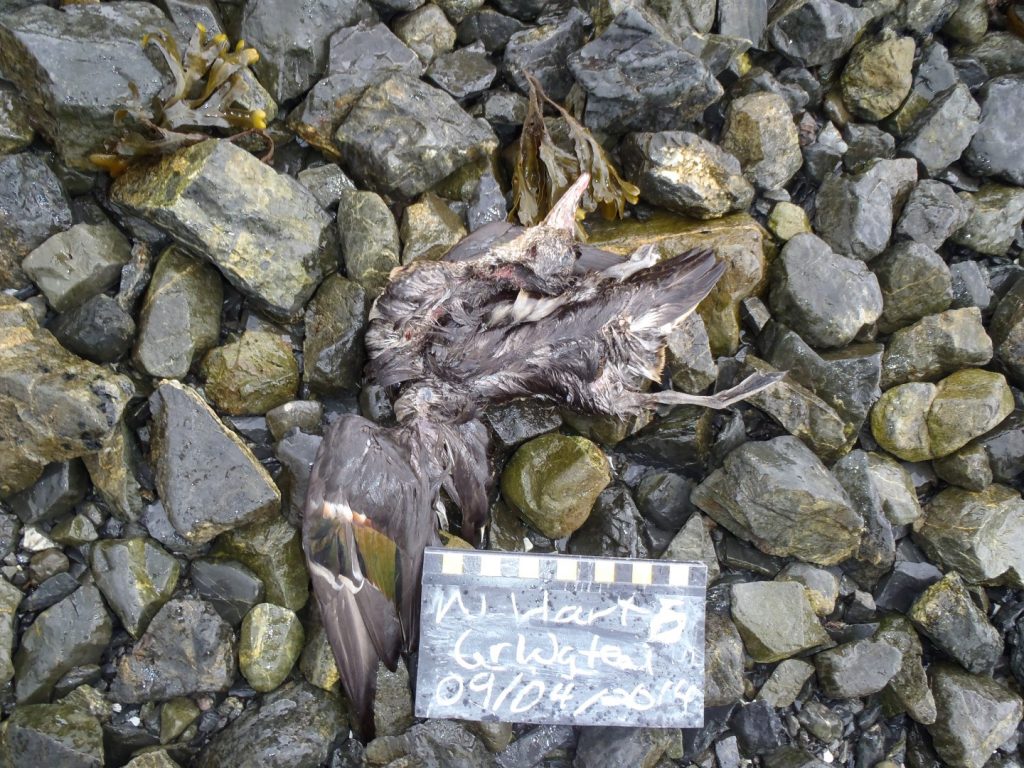September is off to a great start! It’s a busy time in the COASST office – we just completed our first marine debris pilot training session on August 23, and we’re getting ready for beached bird trainings in California and Oregon later this month. We’re also anxiously awaiting the return of our amazing intern crew, as many of them are currently away enjoying the last few weeks of summer. Thank you for all of the datasheets and great photos over the past few weeks.
Let’s take a look at what’s washed in recently: Wing: 11.5 cm, Bill: 45mm, Tarsus: 40mm
Wing: 11.5 cm, Bill: 45mm, Tarsus: 40mm
 Wing: 12 cm, Bill: 24mm, Tarsus: 30mm
Wing: 12 cm, Bill: 24mm, Tarsus: 30mm
Jon and Merrie found the first bird at Oregon Mile 287 on August 14 and Mark found the second bird at Roads End South in Oregon on August 16. With wing chords about equal, which is a chick and which is an adult?
Let’s use the Alaska and West Coast foot key (page 34, 22 respectively) to find out. Q1 select webbed (go to Q2), fully webbed (go to Q3), 3 webbed only (go to Q4), foot small, tarsus <50mm: Alcids
On AL1, both guides split Alcids via wing chord, at 15cm. Both of these birds fall into “Small Alcids,” based on that.
The West Coast guide directs us to look at 2 species: COMUj (AL4), MAMU (AL14).
The Alaska guide directs us to: MAMU (AL17), KIMU (AL19).
Turns out the first is an adult Common Murre, in molt (the process of shedding feathers, in this case, all primaries at one time). Even in the absence of a head (mostly dark, so transitioning out of breeding plumage) or feet, note the pale brown wing plumage, worn secondary tips (just a bit of white remains), long body length.
The second is a juvenile Common Murre, rare in Alaska but quite common along the West Coast, which warrants a separate species profile on page AL4 in the West Coast guide. Even in the absence of feet or a head, note the fluffy breast feathers, small body size, short distance from wrist to elbow, and fresh, dark, wing plumage.
 Wing: 22 cm, Bill: 110 mm, Tarsus: 71 mm
Wing: 22 cm, Bill: 110 mm, Tarsus: 71 mm
Wow! A super rare bird (only the 5th found by COASSTers since 1999)! Janice and Vicki found this bird at Damon Point East in Washington on August 25.
Using the Alaska and West Coast foot key (page 34, 22 respectively): Q1 select free (go to Q9), four free toes (go to Q10), no toes fused (go to Q11), tarsus less than 150mm (go to Q12), no claws (go to Q13), toe pads not fleshy – Shorebirds: 4-toed.
And that’s as far as we can get with the Beached Birds guide. The bi-colored pink-black bill (slightly up-curved) rules out Whimbrel, Long-billed and Bristle-thighed Curlew (bi-colored, but all down-curved). The orange-brown mottled wing with solid orange inner primary patch means this must be a Marbled Godwit.


The first marine debris pilot testers from the Ocean Shores training are in action. Data and photos are beginning to roll in. While surveying Old Mill Mark, Lee found these two lighters. For these common finds, color is an important distinction between the two: red is attractive to many seabird species, and red lighters can be confused with squid, a food favored by albatross as demonstrated in the side by side comparison below.
This photo was taken on Midway and shared with COASST by Claude Gascon, Chief Scientist with the National Fish and Wildlife Foundation.

Back in February, Susan found this skate at Beachside State Park in Oregon. As verified Dr. Jerry Hoff, a Fish Biologist at NOAA, this is most likely a longnose skate (Raja rhina), a common species found all along the west coast, ranging from the Bering Sea to Baja California. Skates are bottom dwellers that inhabit mud and silt bottoms in shallow, nearshore habitats where they lay their eggs. Skates bury themselves in sediment leaving only their eyes showing for camouflage. As seen below, skates have multiples rows of small teeth with raised cusps on both their upper and lower jaw line. Skates capture their prey by pouncing on top of it and trapping it against the seafloor. Their diet consists of marine invertebrates such as worms, mollusks, clams, shrimp, and crustaceans, as well as small benthic fishes.
Dr. Hoff suspects that the skate found on Susan’s beach may have been discarded by either a commercial or sport fishing boat before it washed up on the shore. Skates are often caught accidentally with otter-trawls, longline, and handline fishing gear. Mortality via bycatch is a growing problem for the species, but their populations are still stable. Though full skate carcasses are a relatively rare find on the beach, finding their egg cases is a much more common occurrence (see What’s Washed In – July 28).

























